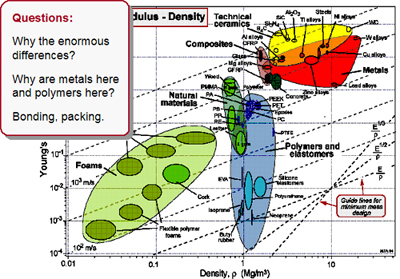Using Material Selection Charts

Material Selection Charts. In order to demonstrate the power of the material selection chart approach, a number of common property combinations have been plotted - these are listed below. A useful method of doing this is by plotting them as Material Property Charts, sometimes called ‘bubble’ or ‘Ashby’ charts, with one property on one axis and another property on the other. Each material has a range of values for each property, depending on the exact composition, grade, heat treatment, supplier etc.
Here is a materials selection chart for 2 common properties: Young's modulus (which describes how stiff a material is) and density.
On these charts, materials of each class (e.g. metals, polymers) form 'clusters' or 'bubbles' that are marked by the shaded regions. We can see immediately that:
- Selector is considered a strategic asset in that the software is well integrated into. 4th Ashby ( Organizational Chart). Use Creately’s easy online diagram editor to edit this diagram, collaborate with others and export results to multiple image formats. Edit this Diagram. Tap diagram to zoom and pan.
- For material selection, MF Ashby of Cambridge University developed this very powerful method of material selection using charts and they're called Ashby plots and there's also a software you can utilize to plot these Ashby plots. And what Ashby plots do is they show you a relation between two material properties across a number of materials.
- metals are the heaviest materials,
- foams are the lightest materials,
- ceramics are the stiffest materials.
Where selection charts are really useful is in showing the trade-off between 2 properties, because the charts plot combinations of properties. For instance if we want a light and stiff material we need to choose materials near the top left corner of the chart - so composites look good.
Note that the chart has logarithmic scales - each division is a multiple of 10; material properties often cover such huge ranges that log scales are essential.
There are a selection charts for many combinations of material properties, e.g. 'strength - toughness' and 'electrical resitivity - cost'. The next section shows how we cantake selection charts further.
Consider a design problem where the specification is for a component that is both light and stiff (e.g. the frame of a racing bicycle). The Young's modulus - density chart helps us to find the best materials - they lie towards the top left. The charts can be annotated to help reveal the 'best' materials, by placing a suitable selection box to show only stiff and light materials. What can we conclude?
This still leaves quite a lot of choices, so what might be considered next to narrow the choice further? |
It is unlikely that only 2 material properties matter, so what other properties are important? Let's consider strength and cost - these properties are plotted on another selection chart. So, what else does this tell us about suitable materials classes? What can we conclude?
|
Ashby Chart Software
Selection charts can also be used to select between members of a given class by populating it with the main materials. For instance, we can do this for metals in the stiffness-density chart. What can we conclude?
Let's summarise what we've learnt about materials selection. |
Ashby Diagram Software Download
Summary:Ashby Plot Software
- By considering 2 (or more) charts, the properties needed to satisfy the main design requirements can be quickly assessed.
- The charts can be used to identify the best classes of materials, and then to look in more detail within these classes.
- There are many other factors still to be considered, particularly manufacturing methods. The selection made from the charts should be left quite broad to keep enough options open. A good way to approach the problem is to use the charts to eliminate materials which will definitely not be good enough, rather than to try and identify the single best material too soon in the design process.